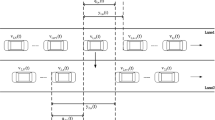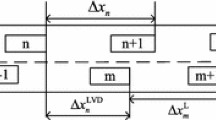Abstract
Based on single-lane traffic model, a two-lane traffic model is presented considering the velocity difference control signal. The stability condition of the model is obtained by the control theory. The delayed feedback control signal is added to the two-lane model, and the corresponding stability condition is derived again. The numerical simulations show that as the stability conditions are satisfied, the small disturbance will not amplify with and without control signal. In the meantime, the stability is strengthened as the control signal is considered. So the control signal would suppress the traffic disturbance successfully.






Similar content being viewed by others
References
Bando, M., Hasebe, K., Nakayama, A.: Dynamic model of traffic congestion and numerical simulation. Phys. Rev. E 51, 1035–1042 (1995)
Peng, G.H., Cai, X.H., Liu, C.Q., Cao, M.X., Tuo, M.X.: Optimal velocity difference model for a car-following theory. Phys. Lett. A 375, 3973–3977 (2011)
Ge, H.X., Cheng, R.J., Li, Z.P.: Two velocity difference model for a car following theory. Physica A 387, 5239–5245 (2008)
Li, Z.P., Liu, F.Q.: An improved car-following model for multiphase vehicular traffic flow and numerical tests. Commun. Theor. Phys. 46, 367–373 (2006)
Li, Z.P., Gong, X.B., Liu, Y.C.: A velocity-separation difference model for car-following theory and simulation tests. IEEE ICNSC 2006, 556–561 (2006)
Li, Z.P., Gong, X.B., Liu, Y.C.: A model of car-following with adaptive headway. J. Shanghai Jiao Tong Univ. 11(3), 394–398 (2006)
Jiang, R., Wu, Q.S., Zhu, Z.J.: Full Velocity difference model for car-following theory. Phys. Rev. E 64, 017101–017105 (2001)
Xue, Y.: One-dimensional traffic model to consider priority of the stochastic deceleration. Commun. Theor. Phys. 41, 477–480 (2004)
Peng, G.H.: A new lattice model of two-lane traffic flow with the consideration of optimal current difference. Commun. Nonlinear Sci. Numer. Simul. 18, 559–566 (2013)
Konishi, K.J., Michio, H., Hideki, K.: Decentralized delayed-feedback control of a coupled map model for open flow. Phys. Rev. E 58, 3055–3059 (1998)
Zhao, X.M., Gao, Z.Y.: A control method for congested traffic induced by bottlenecks in the coupled map car-following model. Physica A 366, 513–522 (2006)
Han, X.L., Jiang, C.Y., Ge, H.X., Dai, S.Q.: A modified coupled map car-following model based on application of intelligent transportation system and control of traffic congestion. Acta. Phys. Sin. 56, 4383 (2007). (in Chinese)
Shen, F.Y., Zhang, H., Ge, H.X., Yu, H.M., Lei, L.: A control method for congested traffic in the coupled map car-following model. Chin. Phys. B 18, 4208 (2009)
Yu, H.M., Cheng, R.J., Ge, H.X.: Considering backward effect in coupled map car-following model. Commun. Theor. Phys. 54, 117 (2010)
Ge, H.X., Cheng, R.J., Li, Z.P.: Considering two-velocity difference effect for coupled map car-following model. Acta. Phys. Sin. 60, 080508 (2011)
Ge, H.X., Yu, J., Lo, S.M.: A control method for congested traffic in the car-following model. Chin. Phys. B 29, 050502 (2012)
Ge, H.X., Meng, X.P., Ma, J., Lo, S.M.: An improved car-following model considering influence of other factors on traffic jam. Physica A 377(1–2), 9–12 (2012)
Chen, X., Gao, Z.Y., Zhao, X.M., Jia, B.: Study on the two-lane feedback controlled car-following model. Acta. Phys. Sin. 56, 2046 (2007). (in Chinese).
Nagatani, T.: Jamming transitions and the modified Korteweg C de Vries equation in a two-lane traffic flow. Physica A 256, 297–310 (1999)
Tang, T.Q., Huang, H.J., Gao, Z.Y.: Stability of the car-following model on two lanes. Phys. Rev. E 72, 066124 (2005)
Tang, T.Q., Huang, H.J., Wong, S.C., Jiang, R.: Lane changing analysis for two-lane traffic flow. Acta. Mech. Sin. 23, 49–54 (2007)
Shingo, K., Nagatani, T.: Spatio-temporal dynamics of jams in two-lane traffic flow with a blockage. Physica A 318, 537–550 (2003)
Zheng, L., Ma, S.F., Zhong, S.Q.: Influence of lane change on stability analysis for two-lane traffic flow. Chin. Phys. B 20, 088701 (2011)
Acknowledgments
Project supported by the National Natural Science Foundation of China (Grant Nos. 11262003, 11302125 and 11372166 Shanghai Science and Technology Commission (No. 12PJ1404000)), the Scientific Research Fund of Zhejiang Provincial, China (Grant No. LY13A010005) and the K.C. Wong Magna Fund in Ningbo University, China.
Author information
Authors and Affiliations
Corresponding author
Appendices
Appendix 1
In this appendix, we present details of linearization and Laplace transformation.
According to the control theory, the vehicular dynamics described by Eq. (4) can be rewritten as a linear time-invariant system, that is
Taking Laplace transformation, we have
where \(V_{l,n}^0(s)=L(v_{l,n}^0(t))\), \(V_{l,n-1}^0(s)=L(v_{l,n-1}^0(t))\), \(V_{l,n-2}^0(s)=L(v_{l,n-2}^0(t))\), \(V_{l,n}^{f0}(s)=L(v_{l,n}^{f0}(t))\), \(V_{l,n+1}^{f0}(s)=L(v_{l,n+1}^{f0}(t))\), \(Y_{l,n}^0(s)=L(y_{l,n}^0(t))\), \(Y_{l,n-1}^0(s)=L(y_{l,n-1}^0(t))\), \(Q_{l,n}^0(s)=L(q_{l,n}^0(t))\), \(Q_{l,n+1}^0(s)=L(q_{l,n+1}^0(t))\), \(\Delta V^*=L(\Delta v^*)\), \(L(\cdot )\) denotes the Laplace transformation. After derivation of Eq. (23), we have the following transfer relationship:
and
Appendix 2
In this appendix, we present details of linearization and Laplace transformation with control signals. Eq. (12) can be given as
After Laplace transformation, we have
So we have the following transfer relationship:
Rights and permissions
About this article
Cite this article
Cui, Y., Cheng, RJ. & Ge, HX. The velocity difference control signal for two-lane car-following model. Nonlinear Dyn 78, 585–596 (2014). https://doi.org/10.1007/s11071-014-1462-6
Received:
Accepted:
Published:
Issue Date:
DOI: https://doi.org/10.1007/s11071-014-1462-6




